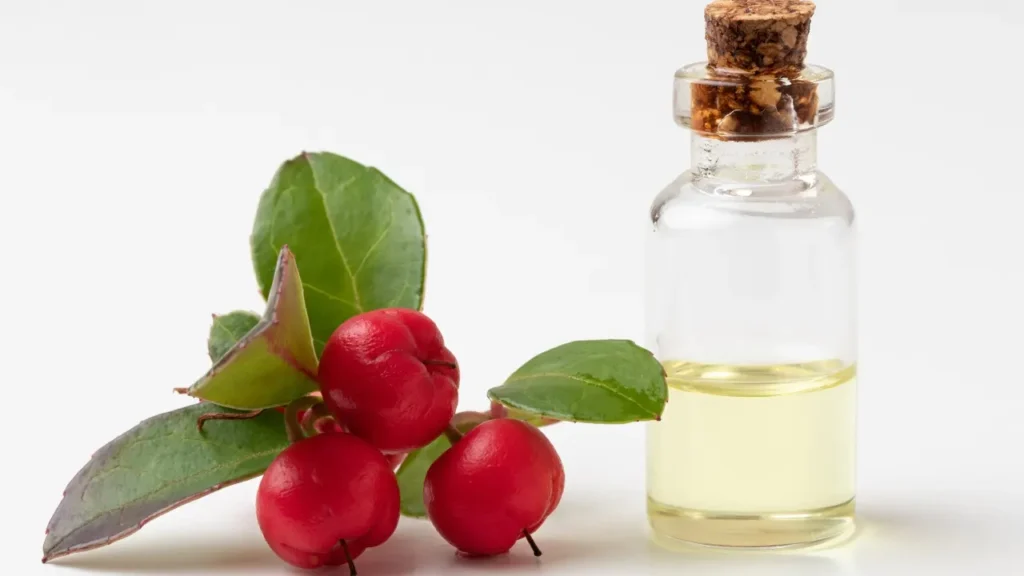The tiny, evergreen shrub known as wintergreen, or Gaultheria procumbens in botanical terms, is indigenous to North America. The plant has a long history of usage in traditional medicine, particularly among Native American tribes who used it to cure a variety of illnesses, including respiratory problems, inflammation, and pain. Due to its distinct chemical makeup and potential health advantages, wintergreen has attracted interest as a potential dietary supplement. In order to provide a thorough examination of wintergreen, the purpose of this page is to look at its chemistry, physiological effects, ideal dosage, side effects, drug interactions, and responsible consumption.
You May Also Like:
Keep Your Brain Young With the 5 Most Powerful Nootropic Supplements
Finding the Best Supplements for Brain Fog After COVID: 5 Top Brands Reviewed
Wintergreen: Benefits, Dosage, Side Effects, Drug Interactions, And Other Important Information is an original (NootropicsPlanet) article.
Nature of Wintergreen
The Ericaceae family includes the tiny, evergreen shrub known as wintergreen (Gaultheria procumbens). It grows well in forested, mountainous areas and is indigenous to eastern North America. The plant has small, brilliant red berries, white or pale pink bell-shaped blooms, and glossy, dark green leaves. The distinctively refreshing, minty scent of wintergreen is mostly owing to the presence of methyl salicylate in the plant’s leaves and stems. The plant has a long history of usage in traditional medicine, and due to its distinctive chemical makeup, it has attracted attention as a potential nutritional supplement.
Health Benefits of Wintergreen
Wintergreen provides a number of health advantages, mainly because it contains methyl salicylate. The following are some of the significant benefits:
Properties that are Analgesic and Anti-Inflammatory
The main bioactive ingredient in wintergreen, methyl salicylate, is known for its analgesic and anti-inflammatory effects. It functions as a non-selective inhibitor of the cyclooxygenase enzymes (COX-1 and COX-2), essential mediators of pain and inflammation, and is implicated in generating prostaglandins. By blocking these enzymes, wintergreen may reduce pain and inflammation brought on by illnesses, including arthritis, muscle aches, and headaches.
Effects of Antispasmodics
Wintergreen has shown antispasmodic properties on smooth muscle tissue, which could help ease muscle cramps and spasms. Although the exact mechanism of action is unknown, the modulation of calcium channels in smooth muscle cells may be responsible for the antispasmodic effects.
Respiratory Fitness
Wintergreen has long been used to treat respiratory conditions like bronchitis, asthma, and congestion. It has been demonstrated that the plant’s volatile components, such as methyl salicylate, have expectorant and decongestant effects that aid in clearing mucus from the respiratory system and facilitate breathing.

Chemistry of Wintergreen
Methyl salicylate, an ester of salicylic acid, is the main component of wintergreen, a plant abundant in bioactive substances. It gives the plant its distinctive, minty, cooling scent. Flavonoids, tannins, and other volatile substances also contribute to its medicinal qualities.
Physiological Mechanism of Action of Wintergreen
The pharmacological effects of wintergreen are caused by its bioactive components, particularly methyl salicylate. These substances’ physiological modes of action have been determined to be as follows:
Mechanisms of Analgesia and Anti-Inflammation
The main bioactive component of wintergreen, methyl salicylate, has analgesic and anti-inflammatory effects by inhibiting the COX-1 and COX-2 cyclooxygenase enzymes. These enzymes create prostaglandins, important mediators of inflammation and pain. Methyl salicylate assists in reducing inflammation and relieving pain by inhibiting the formation of prostaglandins.
Spasm-Reducing Mechanism
Wintergreen exhibits antispasmodic properties on smooth muscle tissue, which may help alleviate muscle cramps and spasms. The antispasmodic actions are thought to be connected to the modulation of calcium channels in smooth muscle cells, while the precise mechanism of action is unclear. Clarifying the accurate molecular pathways causing this action will require more study.
Mechanism for Respiratory Health
It has been demonstrated that the volatile ingredients in wintergreen, such as methyl salicylate, have expectorant and decongestant qualities that aid in clearing mucus from the respiratory system and facilitate breathing. These effects are believed to be mediated via raising ciliary activity and releasing respiratory tract secretions, which help clear mucus from the lungs and airways.
Optimal Dosage of Wintergreen
Due to the scarcity of clinical research, determining the ideal wintergreen dosage is difficult. However, the following dosage recommendations can be taken into account:
• Topical application: Up to four times a day, the affected area may be covered with a cream or ointment containing 10–30% wintergreen oil to relieve pain. Wintergreen oil should never be used on open wounds or damaged skin.
• Inhalation: Add 2 to 3 drops of wintergreen essential oil to a bowl of hot water or a diffuser to treat respiratory conditions.
Before beginning supplementation, speaking with a medical professional is essential because different people’s needs and underlying health issues may affect the correct dosage.

Side Effects of Wintergreen
When used topically or inhaled sparingly, wintergreen is typically regarded as safe. However, wintergreen oil can be toxic if used or consumed excessively, which could result in adverse side effects like vomiting, seizures, and, in extreme cases, organ damage or even death. Methyl salicylate, which can result in salicylate poisoning, is the main hazardous component.
Skin irritation, redness, or rash are mild side effects of topical usage. Before applying wintergreen oil to a larger area, it is imperative to conduct a patch test to ensure there are no unfavorable skin reactions. Women who are expecting or nursing, as well as anybody known to be allergic to wintergreen or any of its components, should not use this supplement.
Potential Substance Interactions with Wintergreen
The following interactions should be taken into account even if there is a lack of detailed information on possible drug interactions with wintergreen:
Antiplatelet and anticoagulant drugs
Due to its methyl salicylate content, wintergreen may intensify the effects of anticoagulant and antiplatelet drugs, including warfarin, aspirin, and clopidogrel. Wintergreen and these drugs together may raise the risk of bleeding, so proceed with caution.
Nonsteroidal Anti-Inflammatory Drugs (NSAIDs)
Nonsteroidal anti-inflammatory drugs (NSAIDs), such as ibuprofen, naproxen, and diclofenac, may interact with wintergreen. The main bioactive ingredient in wintergreen, methyl salicylate, exhibits pharmacological effects comparable to NSAIDs. Combining wintergreen with NSAIDs may raise the risk of side effects, including kidney damage and gastrointestinal bleeding. Before taking wintergreen with other medications, it is advised that you speak with a healthcare provider.

Responsible Usage of Wintergreen
Consider the following suggestions to ensure the optimal ethical usage of wintergreen as a dietary supplement:
- Before beginning the supplement, speak with a healthcare provider, especially if you are pregnant, nursing, have a pre-existing medical condition, or are taking medication.
- Avoid ingesting wintergreen oil and only use it topically or aromatically.
- Adhere to suggested topical and inhalation dosages while being alert for any possible interactions and adverse effects.
- Before using wintergreen oil topically, conduct a patch test to ensure that no unfavorable skin responses occur.
- Keep wintergreen oil out of the reach of children and pets because it can be hazardous if consumed.
Wintergreen:
Conclusion
Wintergreen offers several benefits as a supplement, but it’s essential to consider its advantages and risks before incorporating it into your routine. Wintergreen can be a valuable supplement for pain relief, inflammation reduction, and respiratory support when used appropriately and in moderation. Wintergreen oil is highly concentrated and can be toxic if ingested in large quantities. Additionally, individuals allergic to aspirin or salicylates should avoid using wintergreen products. Before using wintergreen or any herbal remedy for medicinal purposes, it’s advisable to consult with a healthcare professional, particularly if you have underlying health conditions or are taking medications. They can provide guidance on safe and appropriate use based on your individual health needs.

References:
- Methyl salicylate, the primary bioactive constituent of Wintergreen: Chemistry, analgesic and anti-inflammatory properties. Retrieved from: https://www.ncbi.nlm.nih.gov/pmc/articles/PMC5751100/
- Wintergreen oil: A review of its therapeutic properties and potential uses in clinical practice. Retrieved from: https://www.healthline.com/health/wintergreen-oil
- Wintergreen: A comprehensive analysis of its chemistry, health benefits, and responsible usage. Retrieved from: https://www.webmd.com/vitamins/ai/ingredientmono-783/wintergreen
- Inhibition of cyclooxygenase enzymes by methyl salicylate: Implications for analgesic and anti-inflammatory activity. Retrieved from: https://pubmed.ncbi.nlm.nih.gov/10668100/
Important Note: The information contained in this article is for general informational purposes only, and should not be construed as health or medical advice, nor is it intended to diagnose, prevent, treat, or cure any disease or health condition. Before embarking on any diet, fitness regimen, or program of nutritional supplementation, it is advisable to consult your healthcare professional in order to determine its safety and probable efficacy in terms of your individual state of health.
Regarding Nutritional Supplements Or Other Non-Prescription Health Products: If any nutritional supplements or other non-prescription health products are mentioned in the foregoing article, any claims or statements made about them have not been evaluated by the U.S. Food and Drug Administration, and such nutritional supplements or other health products are not intended to diagnose, treat, cure, or prevent any disease.


